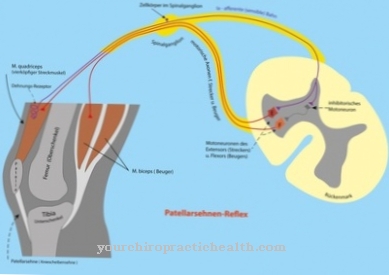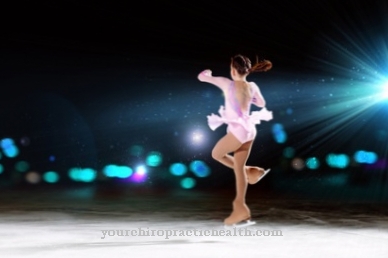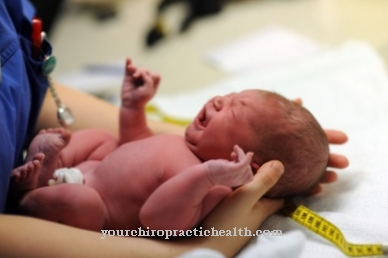The term Gait cycle is used in gait analysis. It is a criterion that is used for an objective description of the gait pattern.
What is the gait cycle?

The gait analysis includes the observation, examination and documentation of the human gait. It can be carried out either with apparatus-based measuring devices that provide objective data, or by experienced observers with the help of specific observation criteria.
The gait cycle is one such criterion that describes the period of time that a leg goes through in a complete stance and swing leg phase. He starts with the heel touchdown at the beginning of the standing leg phase, runs through this until the foot is lifted off, followed by the swing leg phase. It ends when the heel touches down again. The same sequence of movements of the other leg takes place with a time delay of half a phase.
One step comprises half a gait cycle and begins with the lifting of the foot at the beginning of the swing leg phase and ends when the heel makes contact with the ground again at the end. In relation to the entire gait pattern, 2 steps are taken during a gait cycle.
In order to be able to analyze and describe the very complex movement sequence better and more precisely, it is divided into further sub-phases, which are each assigned to the stance or swing leg phase.
Function & task
The gait cycle serves as a descriptive instrument in gait analysis, in particular as an aid for observing the temporal and spatial expansion in side-by-side comparison. In the case of one-sided diseases, the affected leg, the so-called reference leg, is usually assessed in comparison to the other side.
Various criteria are available to analyze quantitative and qualitative processes. The gait rhythm is one such characteristic that affects the entire gait cycle. He compares the time periods in which the gait cycles of both legs or the associated sub-phases take place. In the case of a physiological gait, the respective movement sequences on the left and right are of equal length.
The stride length measures the spatial distance between the tip of one foot to the heel of the other when walking. With this criterion, standard dimensions can be used for comparison, based on which the classification as too short or too long is made. Together with the step frequency, statements can be made about the walking speed and mobility of the observed.
A qualitative criterion for the correct description of the gait cycle is the observation of the coordinative course of the movement process. This means the targeted movement that takes place in the physiological movement paths, without any temporal or spatial deviations.
The documentation of the observation and assessment results is an important aspect for the benefit of a gait analysis, regardless of whether it is created with computer-aided programs or manually using documentation sheets. The knowledge gained can be used for therapy planning and at a later point in time for the comparison of the results after a successful therapy sequence. The success or failure of the treatment then decides whether it is to be continued or terminated as before or modified.
There are three main functional tasks to perform during the gait cycle. At the beginning, coming from the swing leg phase, the weight must be taken over. Thereafter, the weight must be held on one leg while the forward thrust occurs. Finally, in the swing leg phase, the free leg must be moved forward. The prerequisite for these tasks to run correctly and without interference is, in addition to the intact musculoskeletal system, functioning control by the neural network.
You can find your medication here
➔ Medicines for balance disorders and dizzinessIllnesses & ailments
A disturbance of the gait rhythm usually occurs when the timing is normal on the one hand, while on the other hand it is shortened due to illnesses or injuries.
Various causes can reduce the periods in which the standing or swinging leg phase takes place. These include pain, restricted mobility, strength reduction and coordinative disorders. The standing leg phase is often affected when pain is caused or intensified by the pressure that occurs. These can occur as a result of injuries affecting the muscles that have to hold against gravity and do the forward thrust. Tears and muscle fiber tears in the anterior and posterior thigh muscles, the adductors of the hip joint and the calf muscles are common injuries of this type. Meniscus lesions or knee and hip arthroses are such diseases.
In all cases, changes in gait rhythm and stride length are the result, which are expressed in a limping gait, as the standing leg phase on the affected side is shortened in time and space in order to avoid the pain as quickly as possible. The same goes for the swing leg phase, but affects the muscles that move against gravity, especially the hip flexors.
A symmetrical change in stride length and gait cycles occurs in Parkinson's disease. He is known for the typical small step and tripping gait pattern.
Other neurological disorders of the central nervous system can affect the coordinative execution of the gait. The hemiplegia that follows a stroke usually leads to spasticity in the affected leg. In addition to the coordinative components, all other gait criteria have also been changed. The leg is moved forward in a circular motion and with difficulty in targeting and only touches down with the forefoot. The contact phase and the stride length are shortened in order to bring the other leg forward as quickly as possible.
A hallmark of multiple sclerosis and other atactic diseases is the insecure and uncoordinated gait, which is a combination of coordinative problems and a symmetrical change in stride length and lane width. The result is a wide-legged gait that is characterized by uncertainty and shaky, uncoordinated steps. This change in gait pattern can occasionally be observed even after consuming too much alcohol.



.jpg)























